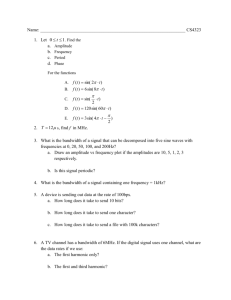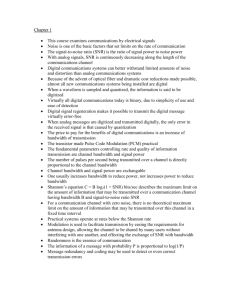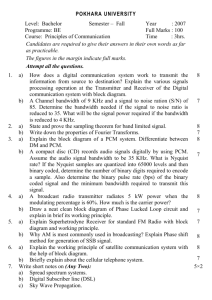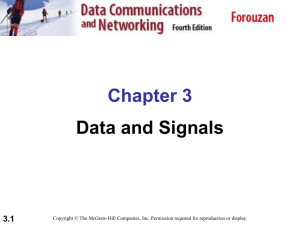Lecture Note Ch.3 - School of Engineering and Technology
advertisement
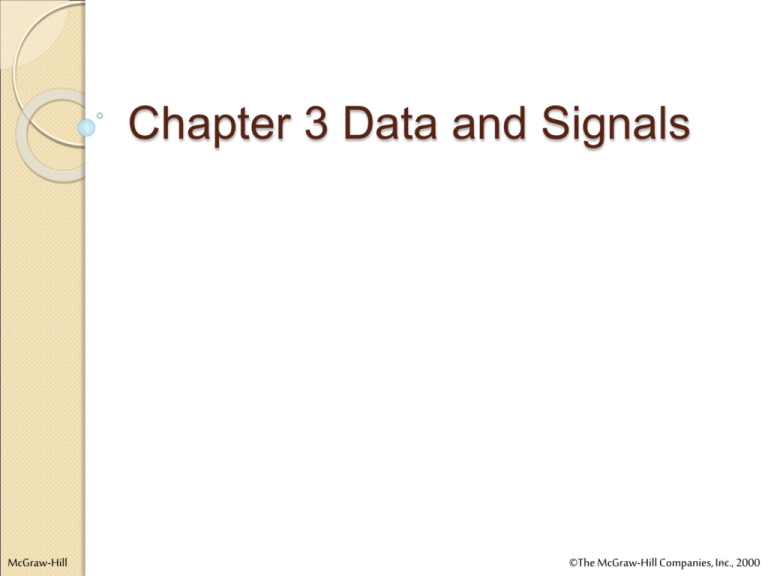
Chapter 3 Data and Signals McGraw-Hill 3.1 2000 ©The McGraw-Hill Companies, Inc., ANALOG AND DIGITAL Data can be analog or digital. The term analog data refers to information that is continuous; Digital data refers to information that has discrete states. 3.2 Comparison of analog and digital signals 3.3 Note In data communications, we commonly use periodic analog signals and nonperiodic (aperiodic) digital signals. 3.4 PERIODIC ANALOG SIGNALS Periodic analog signals can be classified as simple or composite. A simple periodic analog signal, a sine wave, cannot be decomposed into simpler signals. A composite periodic analog signal is composed of multiple sine waves. 3.5 A sine wave 3.6 Example 3.1 The power in your house can be represented by a sine wave with a peak amplitude of 155 to 170 V. However, it is common knowledge that the voltage of the power in U.S. homes is 110 to 120 V. This discrepancy is due to the fact that these are root mean square (rms) values. The signal is squared and then the average amplitude is calculated. The peak value is equal to 2½ × rms value. 3.7 Two Signal with the same phase and frequency, but different amplitudes 3.8 Example 3.2 The voltage of a battery is a constant; this constant value can be considered a sine wave, as we will see later. For example, the peak value of an AA battery is normally 1.5 V. 3.9 Frequency and Period Frequency and period are the inverse of each other. 3.10 Two Signals with the same amplitude and phase, but different frequencies 3.11 Units of period and frequency 3.12 Example 3.3 The power we use at home has a frequency of 60 Hz. The period of this sine wave can be determined as follows: 3.13 Example 3.4 Express a period of 100 ms in microseconds. Solution ◦ From Table 3.1 we find the equivalents of 1 ms (1 ms is 10−3 s) and 1 s (1 s is 106 μs). We make the following substitutions:. 1000μs 100ms 100ms 1ms 105 μs 3.14 Example 3.5 The period of a signal is 100 ms. What is its frequency in kilohertz? Solution ◦ First we change 100 ms to seconds, and then we calculate the frequency from the period (1 Hz = 10−3 kHz). 3.15 Note Frequency ◦ ◦ ◦ ◦ ◦ Frequency is the rate of change with respect to time. Change in a short span of time means high frequency. Change over a long span of time means low frequency. If a signal does not change at all, its frequency is zero. If a signal changes instantaneously, its frequency is infinite. Phase ◦ Phase describes the position of the waveform relative to time 0. 3.16 Same amplitude/frequency but different phase 3.17 Example 3.6 A sine wave is offset 1/6 cycle with respect to time 0. What is its phase in degrees and radians? Solution ◦ we know that 1 complete cycle is 360°. Therefore, 1/6 cycle is 3.18 Wavelength and Period 3.19 Time-domain and Frequency-domain of Single Wave A complete sine wave in the time domain can be represented by one single spike in the frequency domain. 3.20 Example The frequency domain is more compact and useful when we are dealing with more than one sine wave. For example, Figure 3.8 shows three sine waves, each with different amplitude and frequency. All can be represented by three spikes in the frequency domain. 3.21 Time domain and Frequency-domain of Multiple Waves 3.22 Note A single-frequency sine wave is not useful in data communications; we need to send a composite signal, a signal made of many simple sine waves. According to Fourier analysis, any composite signal is a combination of simple sine waves with different frequencies, amplitudes, and phases. (Appendix C) 3.23 Note If the composite signal is periodic, the decomposition gives a series of signals with discrete frequencies; if the composite signal is nonperiodic, the decomposition gives a combination of sine waves with continuous frequencies. 3.24 Example 3.8 Figure 3.9 shows a periodic composite signal with frequency f. This type of signal is not typical of those found in data communications. We can consider it to be three alarm systems, each with a different frequency. The analysis of this signal can give us a good understanding of how to decompose signals. 3.25 A Composite Periodic Signal 3.26 Decomposition of Composite Wave 3.27 Example 3.9 Figure 3.11 shows a nonperiodic composite signal. It can be the signal created by a microphone or a telephone set when a word or two is pronounced. In this case, the composite signal cannot be periodic, because that implies that we are repeating the same word or words with exactly the same tone. 3.28 The time and frequency domains of a nonperiodic signal 3.29 Notes The bandwidth of a composite signal is the difference between the highest and the lowest frequencies contained in that signal. 3.30 The bandwidth of periodic and nonperiodic composite signals 3.31 Example 3.10 If a periodic signal is decomposed into five sine waves with frequencies of 100, 300, 500, 700, and 900 Hz, what is its bandwidth? Draw the spectrum, assuming all components have a maximum amplitude of 10 V. Solution ◦ Let fh be the highest frequency, fl the lowest frequency, and B the bandwidth. Then ◦ The spectrum has only five spikes, at 100, 300, 500, 700, and 900 Hz (see Figure 3.13). 3.32 The bandwidth for Example 3.10 3.33 Example 3.11 A periodic signal has a bandwidth of 20 Hz. The highest frequency is 60 Hz. What is the lowest frequency? Draw the spectrum if the signal contains all frequencies of the same amplitude. Solution ◦ Let fh be the highest frequency, fl the lowest frequency, and B the bandwidth. Then ◦ The spectrum contains all integer frequencies. We show this by a series of spikes (see Figure 3.14). 3.34 The bandwidth for Example 3.11 3.35 Example 3.12 A nonperiodic composite signal has a bandwidth of 200 kHz, with a middle frequency of 140 kHz and peak amplitude of 20 V. The two extreme frequencies have an amplitude of 0. Draw the frequency domain of the signal. Solution ◦ The lowest frequency must be at 40 kHz and the highest at 240 kHz. Figure 3.15 shows the frequency domain and the bandwidth. 3.36 The bandwidth for Example 3.12 3.37 Example 3.13 An example of a nonperiodic composite signal is the signal propagated by an AM radio station. In the United States, each AM radio station is assigned a 10-kHz bandwidth. The total bandwidth dedicated to AM radio ranges from 530 to 1700 kHz. We will show the rationale behind this 10kHz bandwidth in Chapter 5. 3.38 Example 3.14 Another example of a nonperiodic composite signal is the signal propagated by an FM radio station. In the United States, each FM radio station is assigned a 200-kHz bandwidth. The total bandwidth dedicated to FM radio ranges from 88 to 108 MHz. We will show the rationale behind this 200-kHz bandwidth in Chapter 5. 3.39 Example 3.15 Another example of a nonperiodic composite signal is the signal received by an old-fashioned analog black-and-white TV. A TV screen is made up of pixels. If we assume a resolution of 525×700, we have 367,500 pixels per screen. If we scan the screen 30 times per second, this is 367,500×30 = 11,025,000 pixels per second. The worst-case scenario is alternating black and white pixels. We can send 2 pixels per cycle. Therefore, we need 11,025,000 / 2 = 5,512,500 cycles per second, or Hz. The bandwidth needed is 5.5125 MHz. 3.40 DIGITAL SIGNALS In addition to being represented by an analog signal, information can also be represented by a digital signal. For example, a 1 can be encoded as a positive voltage and a 0 as zero voltage. A digital signal can have more than two levels. In this case, we can send more than 1 bit for each level. 3.41 2-level vs. 4-level 3.42 Bit Per Level To send 1 bit per sample needs 2 levels To send 2 bits per sample needs 4 levels. In general, ◦ Need L levels to send log2L bits per sample. 3.43 Example 3.16 A digital signal has eight (8) levels. How many bits are needed per level? We calculate the number of bits from the formula Each signal level is represented by 3 bits. 3.44 Example 3.17 A digital signal has nine levels. How many bits are needed per level? We calculate the number of bits by using the formula. Each signal level is represented by 3.17 bits. However, this answer is not realistic. The number of bits sent per level needs to be an integer as well as a power of 2. For this example, 4 bits can represent one level. 3.45 Example 3.18 Assume we need to download text documents at the rate of 100 pages per minute. What is the required bit rate of the channel? Solution ◦ A page is an average of 24 lines with 80 characters in each line. If we assume that one character requires 8 bits, the bit rate is 3.46 Example 3.19 A digitized voice channel, as we will see in Chapter 4, is made by digitizing a 4-kHz bandwidth analog voice signal. We need to sample the signal at twice the highest frequency (two samples per hertz). We assume that each sample requires 8 bits. What is the required bit rate? Solution ◦ The bit rate can be calculated as 3.47 Example 3.20 What is the bit rate for high-definition TV (HDTV)? Solution ◦ HDTV uses digital signals to broadcast high quality video signals. The HDTV screen is normally a ratio of 16 : 9. There are 1920 by 1080 pixels per screen, and the screen is renewed 30 times per second. Twenty-four bits represents one color pixel. ◦ The TV stations reduce this rate to 20 to 40 Mbps through compression. 3.48 The time and frequency domains of periodic and nonperiodic digital signals 3.49 Transmission of Digital Signals Baseband transmission Broadband transmission (using modulation) 3.50 Baseband transmission Sending a digital signal without changing it to an analog signal A digital signal is a composite analog signal with an infinite bandwidth. Baseband transmission of a digital signal that preserves the shape of the digital signal is possible only if we have a low-pass channel with an infinite or very wide bandwidth. In baseband transmission, the required bandwidth is proportional to the bit rate; ◦ if we need to send bits faster, we need more bandwidth. 3.51 Baseband transmission 3.52 Bandwidths of two low-pass channels 3.53 Baseband transmission using a dedicated medium 3.54 Example 3.21 An example of a dedicated channel where the entire bandwidth of the medium is used as one single channel is a LAN. Almost every wired LAN today uses a dedicated channel for two stations communicating with each other. In a bus topology LAN with multipoint connections, only two stations can communicate with each other at each moment in time (timesharing); the other stations need to refrain from sending data. In a star topology LAN, the entire channel between each station and the hub is used for communication between these two entities. We study LANs in Chapter 14. 3.55 Rough approximation of a digital signal using the first harmonic for worst case 3.56 Simulating a digital signal with first three harmonics 3.57 Bandwidth requirements 3.58 Example 3.22 What is the required bandwidth of a low-pass channel if we need to send 1 Mbps by using baseband transmission? Solution: The answer depends on the accuracy desired. a. The minimum bandwidth, is B = bit rate /2, or 500 kHz. b. A better solution is to use the first and the third harmonics with B = 3 × 500 kHz = 1.5 MHz. c. Still a better solution is to use the first, third, and fifth harmonics with B = 5 × 500 kHz = 2.5 MHz. 3.59 Example 3.22 We have a low-pass channel with bandwidth 100 kHz. What is the maximum bit rate of this channel? Solution ◦ The maximum bit rate can be achieved if we use the first harmonic. The bit rate is 2 times the available bandwidth, or 200 kbps. 3.60 Broadband Transmission Using modulation ◦ Changing the digital signal to an analog signal for transmission Able to use a bandpass channel ◦ A channel with a bandwidth that does NOT start from zero. If the available channel is a bandpass channel, we cannot send the digital signal directly to the channel; we need to convert the digital signal to an analog signal before transmission. 3.61 Bandwidth of a bandpass channel 3.62 Modulation of a digital signal for transmission on a bandpass channel 3.63 Example 3.24 An example of broadband transmission using modulation is the sending of computer data through a telephone subscriber line, the line connecting a resident to the central telephone office. These lines are designed to carry voice with a limited bandwidth. The channel is considered a bandpass channel. We convert the digital signal from the computer to an analog signal, and send the analog signal. We can install two converters to change the digital signal to analog and vice versa at the receiving end. The converter, in this case, is called a modem which we discuss in detail in Chapter 5. 3.64 Example 3.25 A second example is the digital cellular telephone. For better reception, digital cellular phones convert the analog voice signal to a digital signal (see Chapter 16). Although the bandwidth allocated to a company providing digital cellular phone service is very wide, we still cannot send the digital signal without conversion. The reason is that we only have a bandpass channel available between caller and callee. We need to convert the digitized voice to a composite analog signal before sending. 3.65 TRANSMISSION IMPAIRMENT Signals travel through transmission media, which are not perfect. The imperfection causes signal impairment.This means that the signal at the beginning of the medium is not the same as the signal at the end of the medium. What is sent is not what is received. Three causes of impairment are attenuation, distortion, and noise. 3.66 Attenuation A loss of energy through a medium due to the resistance of the medium. Amplifiers are used to amplify the signal to compensate the loss. 3.67 Decibel To measure the relative strengths ◦ Of two signals, or ◦ One signal at two different points P2 dB 10 log 10 P1 P1 and P2 are the powers of a signal at point 1 and 2, respectively. Note: ◦ The decibel is negative if a signal is attenuated and Positive if a signal is amplified 3.68 Example 3.26 Suppose a signal travels through a transmission medium and its power is reduced to one-half. This means that P2 is (1/2)P1. In this case, the attenuation (loss of power) can be calculated as A loss of 3 dB (–3 dB) is equivalent to losing onehalf the power. 3.69 Example 3.27 A signal travels through an amplifier, and its power is increased 10 times. This means that P2 = 10P1 . In this case, the amplification (gain of power) can be calculated as 3.70 Example 3.28 One reason that engineers use the decibel to measure the changes in the strength of a signal is that decibel numbers can be added (or subtracted) when we are measuring several points (cascading) instead of just two. In Figure 3.27 a signal travels from point 1 to point 4. In this case, the decibel value can be calculated as 3.71 Decibels for Example 3.28 3.72 Example 3.29 Sometimes the decibel is used to measure signal power in milliwatts. In this case, it is referred to as dBm and is calculated as dBm = 10 log10 Pm , where Pm is the power in milliwatts. Calculate the power of a signal with dBm = −30. Solution ◦ We can calculate the power in the signal as 3.73 Example 3.30 The loss in a cable is usually defined in decibels per kilometer (dB/km). If the signal at the beginning of a cable with −0.3 dB/km has a power of 2 mW, what is the power of the signal at 5 km? Solution ◦ The loss in the cable in decibels is 5 × (−0.3) = −1.5 dB. We can calculate the power as 3.74 Distortion The signal changes its form or shape occurring in a composite signal ◦ Each signal component has its own propagation speed and delay. 3.75 Distortion 3.76 Noise Many sources ◦ ◦ ◦ ◦ Thermal noise : due to the random motion of electrons Induced noise : from nearby motors and appliances Crosstalk : from other wire Impulse noise : high energy for a short time from power line and lightning 3.77 Noise 3.78 Singal-to-Noise Ratio (SNR) The ratio of the signal power to the noise power average signal power SNR average noise power A high SNR means the signal is less corrupted by noise Usually, the SNR is decribed by decibel units (dB) SNR dB 10 log 10 SNR 3.79 Example 3.31 The power of a signal is 10 mW and the power of the noise is 1 μW; what are the values of SNR and SNRdB ? Solution ◦ The values of SNR and SNRdB can be calculated as follows: 3.80 Example 3.32 The values of SNR and SNRdB for a noiseless channel are We can never achieve this ratio in real life; it is an ideal. 3.81 Two cases of SNR: a high SNR and a low SNR 3.82 DATA RATE LIMITS A very important consideration in data communications is how fast we can send data, in bits per second, over a channel. Data rate depends on three factors: 1. The bandwidth available 2. The level of the signals we use 3. The quality of the channel (the level of noise) 3.83 Noiseless Channel Nyquist bit rate : theoretical maximum bit rate BitRate 2 bandwidth log 2 L According to the formula, ◦ For a given bandwidth, we can have ANY bit rate by increasing the number of signal level. ◦ However, increasing the levels of a signal may reduce the reliability of the system. 3.84 Example 3.33 Does the Nyquist theorem bit rate agree with the intuitive bit rate described in baseband transmission? Solution ◦ They match when we have only two levels. We said, in baseband transmission, the bit rate is 2 times the bandwidth if we use only the first harmonic in the worst case. However, the Nyquist formula is more general than what we derived intuitively; it can be applied to baseband transmission and modulation. Also, it can be applied when we have two or more levels of signals. 3.85 Example 3.34 Consider a noiseless channel with a bandwidth of 3000 Hz transmitting a signal with two signal levels. The maximum bit rate can be calculated as 3.86 Example 3.35 Consider the same noiseless channel transmitting a signal with four signal levels (for each level, we send 2 bits). The maximum bit rate can be calculated as 3.87 Example 3.36 We need to send 265 kbps over a noiseless channel with a bandwidth of 20 kHz. How many signal levels do we need? Solution ◦ We can use the Nyquist formula as shown: ◦ Since this result is not a power of 2, we need to either increase the number of levels or reduce the bit rate. If we have 128 levels, the bit rate is 280 kbps. If we have 64 levels, the bit rate is 240 kbps. 3.88 Noisy Channel: Shannon Capacity In reality, we cannot have a noiseless channel. Shannon capacity determine the theoretical highest data rate for a noisy channel Capacity bandwidth log 2 (1 SNR) 3.89 Example 3.37 Consider an extremely noisy channel in which the value of the signal-to-noise ratio is almost zero. In other words, the noise is so strong that the signal is faint. For this channel the capacity C is calculated as This means that the capacity of this channel is zero regardless of the bandwidth. In other words, we cannot receive any data through this channel. 3.90 Example 3.38 We can calculate the theoretical highest bit rate of a regular telephone line. A telephone line normally has a bandwidth of 3000. The signal-to-noise ratio is usually 3162. For this channel the capacity is calculated as This means that the highest bit rate for a telephone line is 34.860 kbps. If we want to send data faster than this, we can either increase the bandwidth of the line or improve the signal-to-noise ratio. 3.91 Example 3.39 The signal-to-noise ratio is often given in decibels. Assume that SNRdB = 36 and the channel bandwidth is 2 MHz. The theoretical channel capacity can be calculated as 3.92 Example 3.40 For practical purposes, when the SNR is very high, we can assume that SNR + 1 is almost the same as SNR. In these cases, the theoretical channel capacity can be simplified to For example, we can calculate the theoretical capacity of the previous example as 3.93 Using Both Limits In practice, we need to use both theoretical limits 3.94 Example 3.41 We have a channel with a 1-MHz bandwidth. The SNR for this channel is 63. What are the appropriate bit rate and signal level? Solution ◦ First, we use the Shannon formula to find the upper limit. ◦ The Shannon formula gives us 6 Mbps, the upper limit. For better performance we choose something lower, 4 Mbps, for example. Then we use the Nyquist formula to find the number of signal levels. 3.95 Note The Shannon capacity gives us the upper limit; the Nyquist formula tells us how many signal levels we need. 3.96 PERFORMANCE One important issue in networking is the performance of the network—how good is it? We discuss quality of service, an overall measurement of network performance, in greater detail in Chapter 24. In this section, we introduce terms that we need for future chapters. 3.97 Bandwidth In networking, we use the term bandwidth in two contexts. ◦ The first, bandwidth in hertz, refers to the range of frequencies in a composite signal or the range of frequencies that a channel can pass. ◦ The second, bandwidth in bits per second, refers to the speed of bit transmission in a channel or link. 3.98 Example 3.42 The bandwidth of a subscriber line is 4 kHz for voice or data. The bandwidth of this line for data transmission can be up to 56,000 bps using a sophisticated modem to change the digital signal to analog. 3.99 Example 3.43 If the telephone company improves the quality of the line and increases the bandwidth to 8 kHz, we can send 112,000 bps by using the same technology as mentioned in Example 3.42. 3.100 Throughput A measure of how fast we can ACTUALLY send data through a network. Be aware of ◦ The bandwidth is a potential measurement of a link ◦ The throughput is an actual measurement of transmission speed. 3.101 Example 3.44 A network with bandwidth of 10 Mbps can pass only an average of 12,000 frames per minute with each frame carrying an average of 10,000 bits. What is the throughput of this network? Solution ◦ We can calculate the throughput as ◦ The throughput is almost one-fifth of the bandwidth in this case. 3.102 Latency (Delay) How long it takes for an entire message to completely arrive at the destination from the time the first bit is sent out from the source Composed of ◦ Propagation delay : depending on the distance and propagation speed ◦ Transmission time : depending on the message size and bandwidth ◦ Queueing delay : depending on the dynamics of the network ◦ Processing delay : 3.103 Example 3.45 What is the propagation time if the distance between the two points is 12,000 km? Assume the propagation speed to be 2.4 × 108 m/s in cable. Solution ◦ We can calculate the propagation time as ◦ The example shows that a bit can go over the Atlantic Ocean in only 50 ms if there is a direct cable between the source and the destination. 3.104 Example 3.46 What are the propagation time and the transmission time for a 2.5-kbyte message (an e-mail) if the bandwidth of the network is 1 Gbps? Assume that the distance between the sender and the receiver is 12,000 km and that light travels at 2.4 × 108 m/s. Solution ◦ We can calculate the propagation and transmission time as shown on the next slide: ◦ Note that in this case, because the message is short and the bandwidth is high, the dominant factor is the propagation time, not the transmission time. The transmission time can be ignored. 3.105 Example 3.47 What are the propagation time and the transmission time for a 5-Mbyte message (an image) if the bandwidth of the network is 1 Mbps? Assume that the distance between the sender and the receiver is 12,000 km and that light travels at 2.4 × 108 m/s. Solution ◦ We can calculate the propagation and transmission times as shown on the next slide. ◦ Note that in this case, because the message is very long and the bandwidth is not very high, the dominant factor is the transmission time, not the propagation time. The propagation time can be ignored. 3.106 Bandwidth-Delay Product The bandwidth-delay product defines the number of bits that can fill the link. 3.107 Bandwidth-Delay Product, Case A sender sends data in bursts, and wait for ACK for each burst before sending the next burst. What is the size of the burst for a maximum capability of the link? The size of the burst > 2 * bandwidth * delay ◦ To fill up the full-duplex channel. ◦ 2*bw*delay is the number of bits in transition at any time. 3.108 Example 3.48 We can think about the link between two points as a pipe. The cross section of the pipe represents the bandwidth, and the length of the pipe represents the delay. We can say the volume of the pipe defines the bandwidth-delay product, as shown in Figure 3.33. 3.109 Filling the link with bits in case 2 3.110 Concept of bandwidth-delay product 3.111 Jitter Variance of delay 3.112

